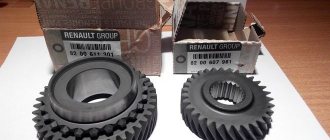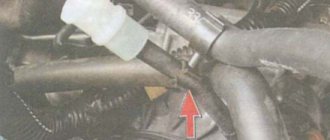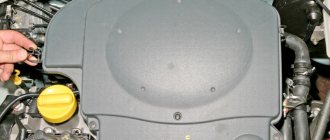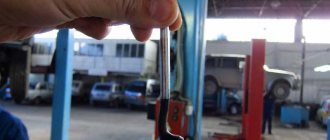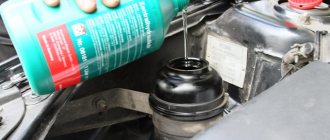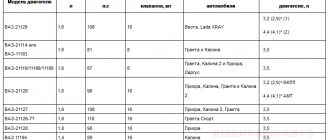Depending on the configuration, the car is equipped with five-speed Renault JH3 and JR5 gearboxes, as well as VAZ-21809 (from 2022), made according to a two-shaft design with synchronizers for all forward gears and combined with a differential and final drive. Transmission fluid is poured into the gearbox at the factory, which is designed for the entire service life of the vehicle. Therefore, there is no need to change the gearbox oil according to maintenance schedules.
Gearbox JH3
Gearbox JH3: 1 – rear gearbox cover; 2 – clutch cable bracket; 3 – clutch fork; 4 – gearbox housing; 5 – breather fitting; 6 – gear shift mechanism; 7 – cavity for the speed sensor; 8 – shaft of the right side differential gear; 9 – clutch housing; 10 – input shaft; 11 – boot; 12 – holder for electrical wires; 13 – oil filler cap; 14 – housing of the internal hinge of the drive mechanism of the left wheel; 15 – reverse light switch
The car engine, like all internal combustion engines, develops power and torque in a relatively narrow speed range. As engine speed decreases, power decreases
The power transmission allows you to reduce the number of revolutions of the drive axle in relation to the number of revolutions of the engine crankshaft, increasing traction force. The higher the traction force, the lower the speed.
When driving a car, it becomes necessary to use different speeds and different traction forces. For example, when driving through deep sand, the speed is insignificant, and a fairly large traction force is required to overcome the resistance of the road. Great traction force is also required when starting the car and overcoming steep inclines. On the contrary, when driving on a paved road, little traction is required, but the speed of movement can be high.
To increase or decrease the traction force on the drive axle while maintaining a constant torque on the engine shaft, a gearbox is used in the vehicle's power transmission.
Due to the fact that the engines of different car models have different power, then, of course, the gear ratios of individual gears, and, consequently, the number of teeth of the gears are different. However, the operating principle of the gearboxes is the same, and the disassembly, assembly and repair operations are generally similar.
The purpose of the gearbox is to ensure further conversion of torque in magnitude and direction in accordance with the load on the vehicle, as well as to enable the engine to idle.
The basic principle of operation of the gearbox is the same everywhere, the essence of which is the pairwise connection of gears that have a different number of teeth. In this case, the torque transmitted by the gears changes in proportion to the gear ratio, i.e. The ratio of the number of teeth on the driven gear to the number of teeth on the drive gear.
A gearbox is, in principle, a very simple device.
Gearbox control mechanism: 1 – bushing (the gearbox control rod is connected to it); 2 – gearbox lever retainer; 3 – gear shift lever (has a ball bearing that is inserted into the body); 4 – lever handle; 5 – plastic body
Gearbox control rod: 1 – coupling bolt; 2 – clamp; 3 – nut; 4 – traction; 5 – traction finger
The rod is attached at one end to the bushing of the gearbox control mechanism, and at the other end to the shift mechanism installed on the gearbox.
Gearbox JR5
Gearbox JR5: 1 – input shaft; 2 – right wheel drive oil seal; 3 – clutch housing; 4 – gearbox housing; 5 – back cover; 6 – breather fitting; 7 – eye-bracket; 8 – gear shift lever; 9 – gear selection lever; 10 – speed sensor or plug; 11 – bracket for fastening transmission control cables; 12 – left wheel drive oil seal; 13 – reverse light switch; 14 – oil filler cap; 15 – tube for supplying fluid to the working cylinder of the clutch hydraulic drive; 16 – clutch release bearing
Gearbox control mechanism: 1 – gear selection cable; 2 – gear shift cable; 3 – control mechanism; 4 – gear shift lever; 5 – gear shift lever cover; 6 – gear lever handle
Gearbox VAZ-21809
Redesigned VAZ gearbox with cable-driven shifting. Installed on Lada Largus instead of the JR5 gearbox from 2022, paired with a 16-valve VAZ-21129 engine. Together with foreign engineers, a number of modifications were made to the box in order to reduce vibration noise, incl. The tooth profile of the gears was changed. Improved clarity and balance of gear shifting.
Tables of gear ratios of the LADA Largus gearbox
Note: gear ratios on cars with AvtoVAZ engines differ from those presented.
Gear ratios of the VAZ-21809 gearbox
| l | 3,636 |
| II | 1,952 |
| III | 1,357 |
| IV | 0,941 |
| V | 0,784 |
| Reverse | 3,500 |
| main gear | 3,944 |
Factory designations and parameters of fifth gear
| Gear ratio | Input shaft gear | Secondary shaft gear | ||
| Number of teeth | Part designation | Number of teeth | Part designation | |
| 0,892 | 37 | 8200611295 | 33 | 8200608035 |
| 0,820 | 39 | 8200611299 | 32 | 8200607980 |
| 0,795 | 39 | 8200611297 | 31 | 8200607978 |
| 0,756 | 41 | 8200611301 | 31 | 8200607981 |
| 0,738 | 42 | 8200611303 | 31 | 8200607983 |
Characteristics of gearboxes in different modifications of Lada Largus
The above models of gearboxes have various modifications designed for installation on certain machines. For example, the JR5 517 gearbox is installed on a van with K4M and K7M engines. The JR5 549 is combined with the K4M engine in both a five- and seven-seat van. The JR5 551 gearbox works with the eight-valve engine on the station wagon, and the JH3 540 modification is usually installed in the five-seater Largus with an eight-valve engine.
Both gearbox models are made of an aluminum alloy housing, in which are mounted:
- differential;
- final drive gear;
- clutch housing.
Inside the Lada Largus gearbox housing there is a primary shaft with a set of drive gears and a secondary shaft with driven gears located next to it. To ensure coordinated operation of the primary and secondary shafts, synchronization rings are installed on them. The difference between the variations of speed boxes lies in the gear ratios between the primary and secondary shafts. The difference between the JH3 and JR5 models is the design of the clutch and gear shift control.
The clutch on the JH3 unit is controlled via a cable connected to the clutch pedal, and gear shifting in the box occurs via a rod connected to the gearshift knob.
In the JR5 model, the transmission of force to the release bearing is carried out by a hydraulic system, which includes the main and working cylinders. The gearbox is controlled by two cables connected to the gear shift knob. At the same time, the cables are not interchangeable; each of them has its own functional purpose.
Before deciding on the purchase of a gearbox, it is necessary to evaluate the features of the automatic and manual transmission. A car with an automatic transmission has a number of advantages over a manual transmission, but it also has undeniable disadvantages.
Advantages and disadvantages of automatic transmission Lada Largus
| Advantages | Flaws |
| Excellent handling | Expensive repairs |
| Good acceleration dynamics | Frequent malfunctions |
| Multiple speed shift modes | High price |
| Ease of driving in urban environments | Inability to start the car when the battery charge is low (from a pusher) |
Therefore, before buying a Lada Largus with automatic transmission, you should weigh the pros and cons. In particular, it is necessary to understand in what conditions the car will be used most often.
Secondary shaft - disassembly and assembly
Disassembly
1. Remove the gearbox.
2. Install the gearbox on a stand for disassembling and assembling units.
3. Remove:
- rear cover of the gearbox housing,
- 5th gear drive gear and synchronizer,
- gearbox housing,
- gearbox shafts.
JH3 gearbox
4. Clamp the secondary shaft in a vice with pads made of soft material.
5. Remove:
- 4th gear gear (1),
- hub and synchronizer clutch for 3rd and 4th gears (2).
6. Remove:
- retaining ring (3) with special pliers and tweezers,
- toothed washer (4).
7. Remove:
- 3rd gear gear (5),
- toothed washer (6).
8. Remove:
- retaining ring (7) with special pliers and tweezers,
- toothed washer (8).
9. Remove:
- 2nd gear gear (9),
- toothed washer (10).
10. Remove:
- retaining ring (11),
- 1st and 2nd gear synchronizer hub (12),
- 1st gear gear (13).
JR5 gearbox
11. The gear bushings of the 2nd, 3rd and 4th gears are installed with an interference fit and must be replaced when assembling the gearbox.
12. Remove:
- bearing outer ring,
- adjusting washer,
- 4th gear gear,
- 3rd and 4th gear synchronizer hub,
- assembly of the “gear bushings, hub, 3rd gear” using a puller and a press with a stop under the ring gear of the 3rd gear (14).
13. Remove the “1st and 2nd gear bushings, hub, sliding clutch” assemblies using a puller and a press with a stop for the 1st gear gear (15).
Assembly
1. Using “SURFACE CLEANER” clean:
- axles,
- shaft mating surfaces,
- gearbox housing.
2. Parts that must be replaced:
- oil seals,
- o-rings,
- clutch release bearing guide sleeve
- gear retaining rings,
- elastic pins,
- retaining rings for primary and secondary shaft bearings,
- synchronizer hub springs,
- hydraulic clutch slave cylinder (if equipped),
- magnet
3. The gear bushing must be replaced (for JR5 gearbox).
4. Check all details.
Points 5-12 refer to CP JH1 or JH3.
5. Clamp the secondary shaft in a vice with pads made of soft material (for gearbox JH1 or JH3).
6. Lubricate the synchronizer locking rings.
Note
:
Correctly position the grooves of the double synchronizer locking ring.
7. Install:
- 1st gear gear (16),
- 1st and 2nd gear synchronizer hub (17),
- retaining ring (18).
8. Install:
- toothed washer (19),
- 2nd gear gear (20).
9. Install:
- toothed washer (21) with special pliers and tweezers,
- retaining ring (22).
10. Install:
- toothed washer (23),
- 3rd gear gear (24).
11. Install:
- toothed washer (25) with special pliers and tweezers,
- retaining ring (26).
12. Install:
- hub and synchronizer clutch for 3rd and 4th gears (27),
- 4th gear gear (28).
Paragraphs 13-18 refer to CP JR5.
13. For installation, use a heating plate with a heating temperature of up to 150 °C.
14. Place new bushings on the heating plate.
15. Heat the bushings for 15 minutes, setting the thermostat to 150 °C.
16. Lubricate the synchronizer blocking rings.
Note
:
Correctly position the grooves of the double synchronizer locking ring.
17. Set in order:
- 1st gear driven gear with synchronizer,
- synchronizer hub for 1st and 2nd gears and align the grooves of the hub with the grooves of the synchronizer blocking ring,
- bushing under the second gear driven gear, using a tubular mandrel with an internal diameter of 33 mm until it stops at the hub,
- 2nd gear driven gear,
- toothed washer between second and third gears,
- the bushing under the third gear driven gear, using a tubular mandrel with an internal diameter of 33 mm until it stops against the toothed washer,
- 3rd gear driven gear,
- synchronizer hub for 3rd and 4th gears and align the grooves of the hub with the grooves of the synchronizer blocking ring,
- bushing under the fourth gear driven gear, using a tubular mandrel with an internal diameter of 33 mm until it stops at the hub,
- 4th gear driven gear,
- adjusting washer,
- bearing.
18. Adjust the secondary shaft.
19. Install:
- gearbox shafts,
- gearbox housing,
- 5th gear drive gear and synchronizer,
- rear cover of the gearbox housing.
20. Remove the gearbox from the stand.
21. Install the gearbox.
Gearbox malfunctions and methods for eliminating them
Any mechanism has a tensile strength, especially if it operates under variable loads. It is necessary to take into account the driver's driving style, which significantly affects the durability of the part. Summarizing the accumulated experience and analysis of breakdowns that occur during the operation of the car, gearbox faults can be grouped into several main groups: noise in the gearbox, difficulty engaging the gear and spontaneous shutdown of the transmission.
Noise and difficulty shifting gears
The main causes of noise in the gearbox include:
- low oil level;
- water entering the system;
- wear of bearings or gears.
To fix the problem, you should add or replace the oil in the gearbox, replace the bearings and gears with new ones.
Difficulty shifting gears can be caused by the following factors:
- faulty gearbox control rod;
- loosening of fastenings;
- deformation of control drive parts;
- wear of synchronization rings;
- incomplete disengagement of the clutch.
The listed faults can easily be eliminated by adjusting the clutch and replacing deformed and worn parts. It also helps to adjust the mechanisms in accordance with the regulations indicated in the car’s operating manual.
Spontaneous transmission shutdown
The reasons for spontaneous shutdown of the gearbox are usually:
- gear wear;
- damage occurs on the rubber supports of the box;
- wear of the synchronizer rings.
These faults can only be corrected by replacing them with new parts. Do-it-yourself transmission repair requires high qualifications and a set of special tools. Only a competent specialist can remove and disassemble this part correctly.
When is it necessary to change transmission fluid?
The danger of operating the Lada Largus is caused by engine tripping. The main reason for this is the use of inadequate quality oil. The machine must be subject to full professional diagnostics in a specialized service center.
Premature replacement of the transmission fluid is possible if, during operation of the Lada, extraneous noise appears and the gears do not work well. If you have difficulty shifting gears, you also need to check the oil level in the manual transmission of your car.
Thus, Lada Largus is a car that can be used for commercial purposes. The car may have a 1.6 liter engine. The transmission is set to “mechanics”. In some cases, it is possible to solve the problem of the functioning of the high-speed gearbox by replacing the transmission fluid.
Features of fifth gear on Largus
Along with the above malfunctions, Largus owners often have a desire to improve the performance of their car, or more precisely, to adapt it to personal requirements. In the main modification, the Lada Largus gearbox comes with a 16-valve engine. The fifth gear ratio (TR) is 0.892. This indicator indicates that the car can move confidently both in city traffic and outside the city. It easily picks up fifth gear from 50 km/h and dynamically reaches its upper speed limit, so there is almost no need to switch to fourth.
However, when driving for a long time at a speed of 90-100 km/h, increased noise occurs and increased fuel consumption is observed. This situation can be corrected by replacing the two fifth gears on the input and output shafts. Replacement takes place with gears that have a lower gear ratio, therefore, fewer teeth. These pairs of gears are sold in aftermarket gear ratios of 0.820, 0.795, 0.756 and 0.738. Experiments on replacing fifth gear gears were carried out by both AvtoVAZ and numerous car enthusiasts.
When using a pair with an IF of 0.820, the fifth gear becomes slightly shorter, as a result the car easily picks up a speed of 60 km/h both on an incline and when driving on a straight road. The noise from the gearbox operation becomes significantly lower.
Gears with a gear ratio of 0.795 slightly change the maneuverability of the Largus. When overtaking, you need to engage fourth gear more often to gain the desired speed. It is often necessary to switch to four when driving on the ground in a loaded car. As for the installation of gears with an IF of 0.756 and 0.738, they aggravate the listed disadvantages.
It is best to replace the factory gears with a pair with a 0.820 ratio.
About the disadvantages of gears
During a thorough and repeated analysis carried out by service centers, as well as based on numerous reviews from owners, it was established that such a malfunction is typical for the LADA Largus modification, which is equipped with a popular 1.6-liter engine (“K4M”) with a 16-valve head design . It is in this version of the engine tandem with the gearbox that the same gear can cause discomfort to the owner, which is why the 5th gear gear is replaced. The manufacturer is also familiar with this shortcoming, which subsequently manifested itself in its desire to use different combinations of not only engines with gearboxes, but also different options for the main pairs in transmissions (see table).
An interesting fact is that the cargo version of the LADA Largus, the so-called “van,” in fifth gear is capable of achieving a higher maximum speed in comparison with its passenger counterpart. The manufacturer intended everything just the opposite.
The noise emitted by the 5th stage gear not only annoyingly penetrated into the cabin, but also caused increased fuel consumption due to the presence of increased friction in the corresponding gearbox unit. That is why many owners of the model replace the fifth gear.
Replacing the fifth gear gear on Largus with your own hands
It is quite difficult to repair a gearbox with your own hands, so experts advise doing it at a service station. However, due to the design features of the gearbox and its location, replacing the 5th Largus gear can be done independently if you have certain skills and experience.
To do this, you must follow clear instructions:
- We put the car on a lift or hang it on stands.
- We remove the left front wheel and carefully, without breaking the clips and pistons, dismantle the engine compartment protection.
- Unscrew the upper fastening of the subframe bracket and move it to the side.
- We drain the oil from the crankcase by unscrewing the drain plug with a square wrench (it is advisable to tighten the plug after draining the oil).
- Remove the reverse sensor connector and the power steering mounting bracket.
- Unscrew the bolts securing the rear gearbox cover.
- We dismantle it, thereby opening access to the fifth gear gears.
Before you begin removing the gears, you need to secure them. To do this, pull the fork towards you and use a special mandrel to knock out the fixing pin. Then you need to return the fork to its original position and engage third gear, recessing the rod next to the fork. After this, pressing on the fork, we engage second gear - now the shafts are fixed.
In the final stage, loosen the bolt securing the gear on the secondary shaft, then unscrew the nut securing the gear on the input shaft, remove the retaining ring and unscrew the already loosened mounting bolt. We dismantle the fork along with the fifth gear clutch. Using a special puller, remove the drive gear, and similarly dismantle the gear on the secondary shaft. Having replaced a set of new gears with the desired gear ratio, we carry out the installation strictly in the reverse order.
It is important to remember that after installing all the removed parts, you should fill the gearbox with oil in accordance with the vehicle's operating instructions.
Reliability jh3
The JH3 gearbox is considered a reliable unit, therefore it is still relevant in the automotive market. Car owners prefer cars with a structurally simple gearbox, partly because of its accessible and cheap maintenance. The disadvantages of manual transmission boil down to the lack of a high level of driving comfort.
The gear shift does not always occur clearly and quickly; sometimes there are jolts and jerking of the vehicle. Structurally, the unit has been fully studied, so even in the event of a serious breakdown, its overhaul will not be difficult. Usually the lever for switching from one speed to another becomes loose ahead of time, which leads to unclear switching.
Often, owners of Lada Largus with JH3 note the noisy operation of the manual transmission and a crunching sound when engaging reverse mode. Early wear of the synchronizers cannot be ruled out. If we close our eyes to some shortcomings, we will get decent mechanics that can go 200-300 thousand km without a single repair.
Checking the oil level and replacing it in the Largus gearbox
Transmission oil is poured into the Lada Largus gearbox at the factory. Its technical and operational characteristics guarantee uninterrupted operation until the end of the vehicle’s service life. Therefore, it is not necessary to add or change oil in accordance with the operating instructions.
Nevertheless, there is an opinion among car enthusiasts that the oil should be changed after 60 thousand kilometers, since metallic inclusions may form in it due to abrasive wear of the gears. Automatic transmissions are more sensitive to the quality of the oil, so in automatic transmissions the oil should be changed after every 50 thousand kilometers.
The volume of oil filled in the JR5 and JH3 boxes is 2.5 and 2.8 liters, respectively. The manufacturer recommends Tranself TRJ or NFJ, NFP and 75W80 gear oils. Detailed instructions for changing the oil in a Lada Largus gearbox yourself include several steps:
- We prepare a container for draining the oil, a 8-square wrench for the drain plug and a syringe for pouring oil into the gearbox.
- We place the car on a lift, overpass or pit.
- Place a container to drain the oil under the drain plug and unscrew the plug.
- We unscrew the filler plug to speed up the draining process.
- After draining the oil, tighten the drain plug.
- We fill the syringe with new oil and fill it through the filler hole.
- The filling process is considered complete when the container is filled to the level of the filler neck.
Advantages of using car services
Offering the best prices in Moscow for repairs of automatic transmissions “Lada Largus Cross I station wagon”, our service stations provide high quality of all preventive and repair work.
Clients consider the main advantages of constant cooperation with our company to be the professionalism of experienced specialists, the speed of work, and our own one-year guarantee on the quality of repairs.
Additional bonuses for customers will be:
- free consultations with auto mechanics, personal order support;
- convenient transport accessibility of services;
- the ability to call a free tow truck;
- range of additional services.
An electronic application on the website or a simple call to the number will help you order diagnostics, maintenance, and repair of automatic transmissions at a time convenient for you.
The first domestic car equipped with an automatic transmission was put into mass production - it was the Lada Granta. In addition to the Granta, in 2013 it is planned to release the Lada Kalina 2 also with an automatic gearbox. The next step of the manufacturer may be the release of the Lada Largus car with automatic transmission.
Regarding this car, as Sergei Korzhenovsky, head of development based on B0, said, the developers had no thoughts about installing an automatic machine. There are some reasons for this. The car is positioned as a budget car, and an automatic transmission is a very expensive thing, which means that a Lada Largus with an automatic transmission will not be a cheap car. The car plant was unable to find proposals from automatic transmission developers that met the price request. After all, at a low price, the gearbox for Largus should be quite powerful with great operational potential, because the car is very heavy. In a word, creating a Largus with an automatic transmission is difficult and expensive.
Today, Lada Largus is equipped with two types of engines with a power of 84 and 105 hp, respectively, 8- and 16-valve. Both types of engine capacity are 1.6 liters. We settled on these options after extensive testing of various engines under the hood of this car. Almost the entire range of AvtoVAZ power units visited there during testing and development. They proved to be not entirely suitable for this car, which is not surprising, because they were developed for less heavy cars with aerodynamics at a higher level than Largus. The diesel engine also had to be abandoned, since its price could not subsequently be compensated by the price of fuel. In the end, it was decided that the Renault alliance power unit would look the best here.
The history of the development of the Lada Largus car is just beginning and now the entire interested public is expecting a modification with a robotic gearbox, as stated by a representative of the car plant. It’s too early to talk about what the price of a Lada Largus with automatic transmission will be. True, we can assume that the manufacturer will retain the position of a budget car.
Auto offers car owners a full range of services for diagnosing and repairing Lada Largus cars at very competitive prices.
Highly qualified specialists of our company have confirmed certificates, so you can be sure that your car is in good hands!
For all Lada Largus models we offer diagnostics:
- computer and complex
- manual and automatic transmission
- engine components
- brake system
- suspension and steering
- electrical system
If defects in components and assemblies are identified, we offer to repair Lada Largus cars in Tula, including:
- major and partial engine repairs
- repair of manual and automatic transmissions
- replacement of timing belt or chain (including scheduled)
- repair and replacement of steering control elements (tips, rack, rod)
- brake system elements
- electrical circuit components, as well as installation of xenon lighting systems
- replacement of basic technical fluids
We have our own large warehouse of spare parts, and also cooperate with licensed suppliers, which allows us to significantly save time and money when selecting spare parts for the car owner himself, and we can ensure the highest quality of work.
Gearbox for LADA Largus
The LADA Largus station wagon (2012 - present) is positioned by the manufacturer as a multifunctional car and is offered to potential buyers in three body styles:
- 5-seater passenger;
- 7-seater passenger;
- 2-seater cargo van.
Moreover, it can be used both as a family and commercial vehicle.
Depending on the configuration, LADA Largus engines are equipped with one of two identical 5-speed manual transmissions:
- JH3 – 5-seater passenger cars equipped with a K7M engine.
- JR5 - station wagons (passenger and cargo) in all other trim levels.
Both boxes are adapted to work in difficult climatic and road conditions characteristic of Russia and the CIS countries.
Important! During assembly, transmission oil is poured into the crankcase, which is designed for the entire service life of the LADA Largus vehicle. In this regard, during maintenance and routine maintenance, an oil change is not required.
Gearbox device
The operating principle of all manual gearboxes is almost the same and consists of pairwise connection of gears with different numbers of teeth. Its task is to ensure a change in torque proportional to the gear ratio. At the same time, different car engines have different power, which forces designers to calculate gear ratios and the number of teeth on gears for each model separately.
Reference! The gear ratio is the ratio of the number of teeth of the driven/drive gears.
The table of gear ratios of the gearbox of the LADA Largus car is given in the table:
The design of the gearbox that powers the power units of the LADA Largus station wagon is almost the same. It is based on a two-shaft circuit with synchronizers for all forward gears. This scheme provides for the presence of two parallel shafts, one of which is driving, and the second is driven. During operation, torque from the input shaft gear is transmitted to the desired secondary shaft gear, which is fixed by a synchronizer. A twin-shaft gearbox can have 4 or more forward gears. The principle of its operation is demonstrated in the video:
The main advantage of the two-shaft design is the possibility of constructively combining the engine and transmission into a compact power unit. However, when implementing such a scheme, it is technically impossible to implement direct transmission, which limits its use in heavy vehicles. It is used in front- and rear-wheel drive passenger cars or heavy motorcycles.
Differences between JH3 and JR5 gearboxes
Despite the structural similarity, the gearboxes of the LADA Largus station wagon have a number of significant differences. In addition to different gear ratios, they are organized differently:
- drive wheel drive connections;
- speed selection;
- disengaging the clutch;
- connection of driving wheels.
Clutch on/off unit:
- The clutch in the JH3 gearbox is engaged/disengaged using a clutch with a bearing, which is moved by a special fork along a guide sleeve. In this case, the latter is connected by a cable to the clutch pedal.
- In the JR5 gearbox, the process of engaging/disengaging the clutch is carried out by a working hydraulic cylinder combined with the clutch release bearing. The working cylinder is connected to the main hydraulic cylinder by a separate pipeline. The clutch pedal acts on the master cylinder rod.
The speed selection in the JH3 gearbox is controlled by a rigid rod, while in the JR5 it is controlled by two flexible cables.
Checkpoint identification
The type of specific gearbox installed on the LADA Largus engine is indicated on a special plate located on the lower part of the crankcase. The plate contains the following information:
- gearbox type - JH3 or JR5;
- gearbox modification;
- factory number;
- manufacturer code.
Gearboxes manufactured at:
- PJSC "AvtoVAZ" - the letter "P";
- to a third party - with the letter “A”.
Brakes
Brake pads, Drum pads, Pad wear sensor, Pad repair kit, Pad spacer, Rear pads, Handbrake pads, Front pads, Brake linings, Brake discs, Rear brake discs, Front brake discs, Brake drum, Rear brake drum, Drum bearing, Brake hoses, Brake pipes, Brake caliper, Caliper repair kit, Rear caliper, Caliper guides, Front caliper, Caliper piston, Caliper boot, Caliper bracket, Hydraulic accumulator, Vacuum brake booster, ABS, ABS unit, ABS sensor, Vacuum pump, Brake pedal, Switch Brake Light, Air Brakes, Parking Brake, Handbrake Cable, Brake Cylinder, Master Cylinder, Brake Reservoir, Brake Service Cylinder, Rear Brake Cylinder, Front Brake Cylinder, Brake Cylinder Repair Kit
Source
About the domestic VAZ 11189 engine
In April 2022, AvtoVAZ began installing domestic VAZ 11189 engines on Largus. The advantages of this engine are described in one of the issues of “Okay Mechanics”.
| Some measurement results Autoreview | |||
| Options | Cars | ||
| Lada Largus (VAZ engine) | Lada Largus (Renault engine) | ||
| Maximum speed, km/h | 157,1/156,7* | 168,0/167,6 | |
| Acceleration time, s | 0—50 km/h | 4,3/4,8 | 3,9/4,4 |
| 0—100 km/h | 13,9/16,8 | 12,5/14,5 | |
| 0—150 km/h | 61,1/71,6 | 38,9/43,7 | |
| on the way 400 m | 19,3/20,2 | 18,4/19,4 | |
| on the way 1000 m | 36,1/37,8 | 34,1/36,0 | |
| 60-100 km/h (III) | 8,7/10,6 | 9,3/10,6 | |
| 60-100 km/h (IV) | 12,1/15,1 | 12,8/14,1 | |
| 80-120 km/h (V) | 19,3/24,0 | 22,1/23,4 | |
| * Partial load/full load | |||
| Engine characteristics | ||
| Options | VAZ-11189 | Renault K4M |
| Volume, cm 3 | 1596 | 1598 |
| Number of valves | 8 | 16 |
| Maximum power, hp/kW/rpm | 87/64/5100 | 102/75/5750 |
| Maximum torque, Nm/rpm | 140/3800 | 145/3750 |
| Cylinder diameter/piston stroke, mm | 82,0/ 75,6 | 79,5/80,5 |
| Compression ratio | 10,3:1 | 9,8:1 |
| Injection type | distributed, electronically controlled | |
| Octane number of gasoline | at least 92 | not less than 95 |
Reliability jr5
It’s difficult to praise the mechanical JR5 in any way, but there’s nothing particularly to reproach either. The unit itself is structurally simple, often hums, and the clarity of gear shifting leaves much to be desired. Over time, it requires overhaul or, in severe cases, replacement due to the destruction of key mechanisms. Often, car owners have to disassemble the box because the 5th speed refuses to turn off.
New Lada: Repair instructions for the stove on the Lada Priora
A roller bearing with a plastic cage on the secondary shaft is another weak point of the JR5 mechanics. The separator often falls apart even at short mileage, which leads to balls clumping together. At a minimum, the manual transmission starts to hum, but there have been cases when balls got caught between the gears. The deficiency was eliminated after the JR5 modernization.
Many problems can be avoided if you follow the manual transmission maintenance regulations and use original oil. It is advisable to change the working material of the box every 50-60 thousand kilometers. TranselfTRJ 75W-80 is suitable for replacement. After passing 10-15 thousand km, it is necessary to take control measurements of the fluid.
Motors
Gradually, the “French” were replaced by the VAZ-11189 (8 valves, 87 hp) and VAZ-21129 (16 valves, 106 hp) engines. The cylinder block traces its history back to engine 21083. These engines are more powerful and more economical than French ones, but less reliable. The VAZ-21129 is equipped with hydraulic compensators; on some examples they knock loudly when warming up. Floating speeds and tripping can be caused by various reasons - from sensor glitches and deformation of the throttle valve ring to spark plug failure or clogged injectors. Burnout of valves happens, but is not a system problem. In general, the motors are well adapted to repair and last a long time.
All engines have a weak link - the thermostat, whose failures lead to “underheating” or overheating.
